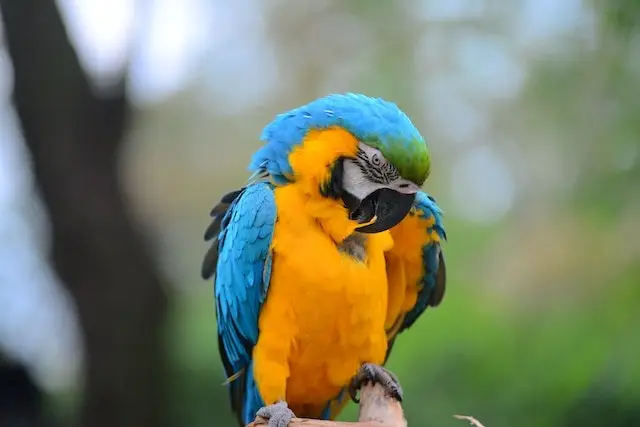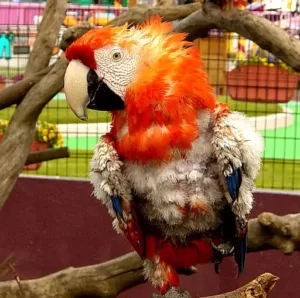Parrots do not have a perfect coat of feathers all year round. It is normal to find a few feathers in your parrot’s cage every now and then.
One common reason for feather loss is molting. It is when the parrot’s old feathers fall off and new ones take their place. But if your parrot is losing feathers outside of the molting season, it can be a concerning matter.
Abnormal feather loss usually occurs in small patches and can be due to multiple causes. Parrots can lose their feathers for a number of reasons including stress, skin problems, mites, health conditions, and sometimes their own unhealthy habits.
Quick Navigation
Why Is My Parrot Losing Feathers?
There are many factors that can cause parrots to lose feathers. These could be related to health and behavior. Here are some common causes that are likely the reason why your parrot is losing its feathers:
Molting
Molting is a periodic trigger for feather loss in parrots. New owners who aren’t aware of this phenomenon in birds often get worried when they see their parrot losing feathers in clumps.
But this is a natural process that involves the replacing of worn-out feathers with new and brighter ones. Most parrots molt twice a year. The first molt usually occurs during the fall and the second one in early mid-winter.
If your parrot’s feathers are falling out in the molting season, it is generally nothing to worry about. In fact, it is a good thing and you’ll soon be seeing more vibrant-looking feathers on your parrot’s skin.
However, do check the pattern in which the feathers fall off. Typically, during a molt, the shedding is diffuse and starts with the innermost feathers.
Prolonged Stress
Parrots aren’t able to express their emotional state like we do. Some parrots may vocalize loudly to get themselves heard while others may go completely mute. Regardless of how they may react to it, stress can be taxing on their delicate bodies.
Being exposed to stress for a considerable amount of time can take a toll on your parrot’s physical health and may sometimes manifest in the form of abrupt feather loss.
In addition to that, when a parrot is stressed, it may also stop preening its feathers regularly which can lead to a dull and lackluster appearance of the feathers.
Stress can affect parrots in various ways and it is often hard to treat without identifying the specific trigger.
Shock Molt
Parrots may sometimes shed their feathers out of shock – a phenomenon called “fright molt.” During a regular molt, a parrot gradually replaces its feathers over the course of a few months. This process happens slowly, with old feathers falling out and growing back in phases.
However, in a shock molt or fright molt, the bird purposely sheds its feathers due to a scary or threatening event. This is commonly seen when a parrot is having a nightmare. When a parrot goes through an episode of night fright, you may find fallen feathers around its cage. These are usually the tail feathers.
According to Birds Online, fright molt is a protective reflex birds use when faced with a sudden threat or danger. This type of molting is voluntary and intended to confuse its predators, allowing the bird a chance to escape from harm.
Inappropriate Cage Size
If a parrot is kept in a cage that is too small for its size or is crowded with toys, it may not be able to move freely. So when a parrot moves quickly inside the cage, it may accidentally brush its feathers against the cage bars or toys, causing feather breakage. However, in this case, the feathers will often break from the middle rather than fall out.
To avoid this, make sure to get the right-sized cage for your parrot, giving it plenty of room to move and play comfortably. You should also regularly check the cage for any sharp or protruding parts that could harm the parrot’s feathers.
Feather Mites
Like all animals, parrots aren’t immune to external parasites. They can be infected by various types of feather-biting parasites such as mites, fleas, and lice.
A parrot may usually catch them by means of an unsanitary environment. Other times, it may be passed from an infested bird when it comes in contact with the parrot.
Feather mites can cause intense itching in parrots, which consequently forces them to preen constantly in an attempt to get rid of the mites. This eventually makes the parrot start picking on its own feathers and leads to feather loss in that particular area.
Skin infections
Bacteria and fungi can often affect parrots’ skin, especially when their environment isn’t kept clean. These microorganisms can make their way into the parrot’s body and affect its skin and feathers.
Parrots with skin infections may show signs of feather loss in patches, redness, and itching. If you notice these symptoms on your parrot’s skin, it’s essential to take them to the veterinarian. The vet will examine the bird’s condition, and if necessary, provide antibiotics or antifungal medications to treat the infection.
Poor Diet
Too little nutrients in the diet can also lead to feather loss in parrots. Malnourishment often occurs when a parrot only eats seed based diet or refuses to eat healthy foods.
This causes the feathers to lose their shine and vigor and eventually fall out. And if the diet is not corrected, the bird may not regrow healthy feathers after a molt.
There may be new feathers on the parrot’s body but they may look scruffy and greasy. These weak feathers may also not last for long and soon shed.
However, things can turn around by improving your parrot’s diet. A healthy diet is important for your parrot’s health and thus to regain its lustrous feathers. To promote healthy feather growth focus on the key nutrients that are needed for feather production such as Vitamin – A, protein, and carotenoids.
Feather Plucking
Chewed-up feathers and bald spots are prominent signs of feather-plucking behaviors in parrots. Feather plucking is a serious behavioral issue that can have many reasons.
Stress and boredom have been observed as the most common triggers of feather plucking in parrots. A parrot that is deprived of social needs often resorts to such destructive behavior due to frustration.
While you can discourage this habit by using an Elizabethan collar or by applying diluted apple cider vinegar to your parrot’s feathers, it does not solve the root of the problem.
Over Preening
Over preening is often what precedes feather plucking in parrots. It happens when a parrot grooms its feathers too much, even though you may not see any visible harm to the feathers at first.
With over-preening, the feathers may fall out in small amounts, and the feather loss might occur in specific areas, particularly around the neck. You may be able to see the lost feathers more noticeably when the bird turns its head.

Health Conditions
Parrot feathers come in many colors and patterns, which makes them unique. But all healthy feathers have one thing in common – they are bright and strong.
Hence, when a parrot is sick, its feathers may lose their luster and appear dull and scruffy. Along with a change in appearance, the feathers might also suddenly fall out.
There can be many diseases associated with feather loss so it is important to recognize when your parrot may be ill.
Psittacine Beak and Feather Disease is a viral condition that affects all parrot species. Affected parrots may show abnormal growth of feathers. The feathers may also break off upon handling.
If your notice these signs, you should take your parrot to an avian vet for a complete diagnosis. There can be a number of other diseases that may affect the condition of your parrot’s feathers.
Parrot Losing Feathers FAQs
Why Is My Bird Losing Feathers Around His Neck?
If your bird is missing a patch of feathers from its neck, it could be due to molting or over-preening. The neck feathers are the most easily accessible for the parrot to pluck feathers from so it would typically start there. However, there may be other reasons as well such as itching or an infection in that region.
Why Is My Bird Losing Tail Feathers?
If your parrot is losing its tail feathers it could be due to the normal molting process or due to stress. During molting, the flight feathers are often the first to shed along with the tail feathers.
However, if the feather loss occurs outside of the regular molting cycle, it might be a sign of stress. Parrots can intentionally shed their tail feathers during a stressful situation such as being chased by another pet or having a fight with other birds.
Why Is My Bird Losing Feathers Around His Eyes?
Feather loss around the eyes is usually a sign of scaly face mites infestation. These mites commonly affect the face and leg areas of parrots which can cause itching and feather loss. You may also notice crusts forming around your bird’s eyes.
If left untreated, scaly face mite infestations can be fatal for the bird. Therefore, it is best to seek veterinary assistance for proper diagnosis and timely treatment.
Why Is My Bird Losing Feathers On His Chest?
Parrots can lose feathers on their chest for a variety of reasons. It could be due to a seasonal molt, over-preening, or parasitic infection in that area. If the feather loss appears to be patchy, you should see an avian vet.
Why Is My Bird Losing Feathers On His Head?
A bald patch on the bird’s head could be caused by a few different factors. Many parrot species have a partial molt which happens around late spring where only their head and body feathers fall off. This molt usually doesn’t last too long and your parrot’s feathers should come back in a month.
One other possible reason for losing head feathers could be over-preening by another bird. If you have another bird in the cage with your parrot, it may be assisting in preening which may sometimes get excessive.
Why Is My Bird Scaly And Losing Feathers?
If your bird’s skin appears scaly and you notice significant feather loss, it may be infected with scaly face mites. These mites affect the face, legs, and feet of birds, causing the skin to thicken and form crusts. They burrow into the bird’s skin and can be harmful. If you observe these symptoms in your bird, take it to a veterinarian as soon as possible.
Do Parrots Feathers Grow Back?
Parrots’ feathers undergo a continuous cycle of shedding and regrowth throughout their lifetime. This natural process allows feathers to grow back at regular intervals completing the cycle of replacing old feathers.
In some cases, where the feathers fall out for unnatural reasons, they can still grow back. However, the time it takes for feathers to fully regrow can vary depending on the extent of damage to the skin and follicles.
Even in cases where the feathers have been plucked or damaged due to over-preening, there is hope for regrowth, though, it may take significantly more time.
Feather plucking can prevent new feathers from growing if the bird does not stop the behavior. But the damage is not permanent and the feather may grow back in a 10-12 months period.







